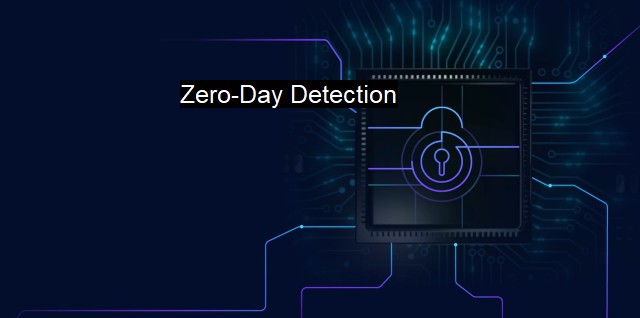What is Zero-Day Detection?
Uncovering the Unseen: The Critical Role of Zero-Day Detection in Cybersecurity and Antivirus Software
"Zero-Day Detection" is an important concept with particularly in relation to antivirus software. To fully appreciate the role and importance of Zero-Day Detection, it's vital to recognise its significance in the broader arena of cyber protection and delve into what precisely this term denotes.A "zero-day" refers to a vulnerability in an operating system or application that is unknown to the individuals or organizations responsible for patching or mending the system. The term denotes that developers have “zero days” to correct an issue that has just been discovered, hence, remaining vulnerable to potential exploitation. The exploit that targets such vulnerabilities is called a “zero-day exploit.” These zero-day vulnerabilities are extremely cumbersome since by their very definition, they are not known until they're exploited, leaving systems defenseless against such attacks.
Stormy waters get murkier in the fact that cybercriminals are persistently on the hunt for such zero-day vulnerabilities. Upon detection, these loopholes provide them with an opportunity to create and implement an exploit before the developers are even aware of the issue, much less have a solution ready to counter it.
This is where Zero-Day Detection climbs into ranks of vital importance. It essentially refers to the capacity of an antivirus software or cybersecurity system to detect and respond to zero-day exploits. Since the traditional or “signature-based” approach where antivirus software depends on previously identified threat signatures to detect and remove threats is ineffective here, a different treatment for zero-day vulnerabilities is obligatory.
Zero-Day Detection methodologies often employ heuristic and behavior-based approaches. Here, rather than scanning for known threats, the system evaluates the behavior of files and applications, flagging those activities or operations that appear suspicious or malicious. The system may then isolate or eliminate such potentially harmful elements, thereby providing a buffer of protection against unseen threats even before a patch is made available.
Advanced persistent threat (APT) groups are widely known to use zero-day exploits and are a major driving force behind the escalation of zero-day threats. As such, it becomes crucial for antivirus software and cybersecurity tools to continually involve and improve their zero-day detection capabilities. Machine learning (ML) and artificial intelligence (AI) are playing increasingly significant roles in this regard, enhancing the ability of systems to learn from previous intrusions and hence, adding additional layers of sophistication to zero-day detection.
Consequently, the measure of a good antivirus software or cybersecurity system is often reflected in their Zero-Day Detection capabilities. Out-of-the box insights and robust responses to zero-day vulnerabilities can mean the difference between a potentially crippling data breach or minor inconvenience. In this light, Zero-Day Detection forms a cardinal dimension of a holistic security approach, providing the much-needed early warning system to fend off previously unknown cyber threats.
Looking forward, the escalation of zero-day threats and the rapid development of technology stand to further intensify the complexity and tenacity of cyber protection. Continued commitment towards improving Zero-Day Detection capabilities are poised to shape and define the next stages of a resilient cybersecurity landscape.
Zero-Day Detection is key to ensuring cybersecurity and an indispensible facet of any competent antivirus software. In today's connected world, the scale and severity of losses that could come from zero-day exploits only underscores the criticality of prompt and precise detection methods, giving organizations and individuals alike optimal chances to secure their systems and data.

Zero-Day Detection FAQs
What is zero-day detection?
Zero-day detection refers to the ability of an antivirus program to detect and protect against new or previously unknown malware threats that exploit vulnerabilities, or "zero-day" vulnerabilities, in software applications.How does zero-day detection work?
Zero-day detection works by using advanced techniques such as behavioral analysis, machine learning, and heuristic scanning to identify patterns of behavior that may indicate the presence of a zero-day threat. These techniques enable the antivirus program to detect and prevent attacks in real-time, even if the malware is not yet known or has never been seen before.Why is zero-day detection important in cybersecurity?
Zero-day detection is important in cybersecurity because it enables organizations to protect themselves against new and emerging threats that may otherwise go undetected by traditional security measures. Cybercriminals are constantly developing new attack methods and exploiting vulnerabilities in software, so the ability to detect and prevent these attacks in real-time is critical to maintaining a strong security posture.Can zero-day detection guarantee 100% protection from malware?
While zero-day detection is an important part of a comprehensive cybersecurity strategy, it cannot guarantee 100% protection from malware. Cybercriminals are constantly finding new ways to evade detection, and it is possible that a zero-day attack could go undetected. That said, zero-day detection can significantly reduce the risk of an attack and provide an extra layer of protection against emerging threats.| | A | | | B | | | C | | | D | | | E | | | F | | | G | | | H | | | I | | | J | | | K | | | L | | | M | |
| | N | | | O | | | P | | | Q | | | R | | | S | | | T | | | U | | | V | | | W | | | X | | | Y | | | Z | |
| | 1 | | | 2 | | | 3 | | | 4 | | | 7 | | | 8 | | |||||||